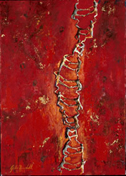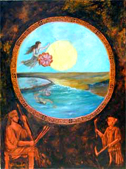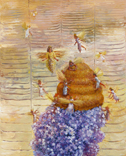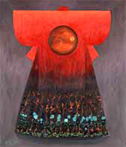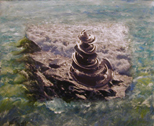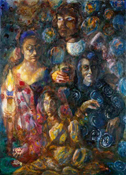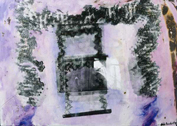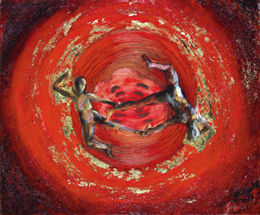
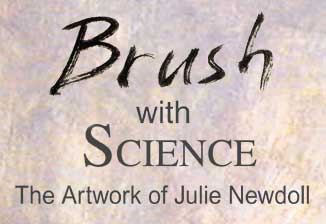
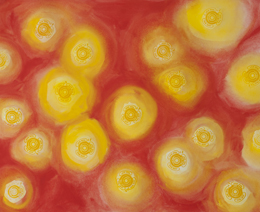
...Julie Newdoll merges life science and culture, myths and molecules in her
paintings, music, journal covers and science games.
Shakespeare:
A Mirror up to Science

An image of this painting was used in the Nobel Prize speech by Elizabeth Blackburn in 2009 for Physiology or Medicine "for the discovery of how chromosomes are protected by telomeres and the enzyme telomerase".
The purple flowers in this painting represents the end of a condensed chromosome, capped off at the end with a hive that symbolizes a telomere. Telomeres in part serve to protect each chromosome by preventing them from unravelling, sticking to other chromosomes, being chewed away by enzymes and the like. Various proteins, such as telomerase, help to protect the telomere and lengthen it when needed. The most current
understanding about how proteins interact with the telomere has been described by Elizabeth Blackburn as “bees buzzing around a hive rather than a rigidly interlocked defensive wall.”* Blackburn discovered telomerase and pioneered the field of telomere research. As cells divide, they loose a portion of their telomeres. When they become too short, the cell stops dividing. This discovery sparked great hopes and research around the idea that maintaining telomere length might result in a longer life.
Bees have a long history with human kind, and ancient rings show goddesses as bees from Sumerian times. The artist found it fitting that in a field pioneered by a woman, which includes many prominent women scientists who have benefitted from her
guidance, a Queen Bee and her Priestesses should be used to represent the proteins swarming about the telomere “hive”.
*From page 205 of the book “Elizabeth Blackburn and the Story of Telomeres” by Catherine Brady, The MIT Press, 2007, and personal communication with Professor Blackburn.

Shiva as Telomerase Creating a Telomere, 25" x 33", 2000. Private collection. Prints available $450.
The telomere is like the shoelace cap on the ends of a shoelace, keeping the lace (chromosome) from unraveling. Each time a human cell divides, all the chromosomes must also divide. The telomere gets shorter when the cell divides, and the protein “telomerase” inside the telomere binding complex lengthens the telomere again.
The telomere is a complex structure that at one time was believed to be a region where the double strand of DNA has folded over onto itself to form a quadruplex, or four stranded helix instead of the normal two stranded helix in the rest of the chromosome. Telomerase and the telomere binding complex help to stabilize this structure and lengthen it after cell divisions have shortened the telomere.
The telomere is now believed by some to be be a large loop with a small triplex loop of DNA holding the end of the telomere onto the chromosome. This is reflected in the painting "Shiva as Telomerase inside of a Telomere Loop," the next painting below.
Shiva is the dancing manifestation of the Hindu god Nataraja. The dance of Shiva represents a delicate balance of creation and destruction, preservation and evolution, a life force as well as death.
Inspired in part by the paper "The Crystal Structure of a Parallel-stranded Guanine Tetraplex at 0.95 A Resolution" by Kathryn Phillips, Zbyszek Dauter, Alastair I. H. Murchie, David M. J. Lilley, and Ben Luisi, J. Mol. Biol. (1977) 273, 171-182, and the paper "Telomeres and Telomerase: more than the end of the line", by Mary-Lou Pardue and P.G. DeBaryshe, Chromosoma. 1999 May;108(2):73-82. Review. Information on Shiva from "Nataraja in Art, Thought and Literature" by C. Sivaramamurti, Thomas Press Ltd., New Delhi, ISBN 81-230-0092-8.
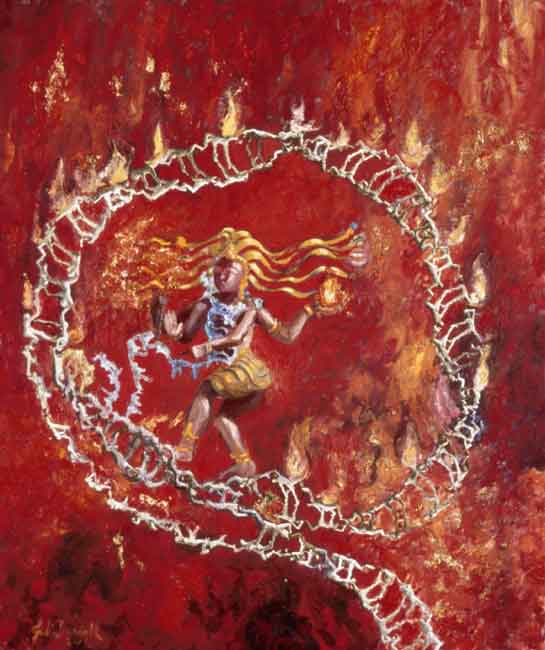
Shiva is the dancing manifestation of the Hindu god Nataraja. The dance of Shiva represents a delicate balance of creation and destruction, preservation and evolution, a life force as well as death. Here Shiva is dancing inside of a telomere loop, acting as the enzyme telomerase. The telomere is like the shoelace cap on the ends of a chromosome, keeping the lace (chromosome) from unraveling. Each time a human cell divides, all the chromosomes must also divide. The telomere gets shorter when the cell divides, and the protein “telomerase” inside the telomere binding complex lengthens the telomere again. Telomerase also stabilizes the telomere. The telomere has now been shown to be a large loop called a telomere loop next to a smaller loop, the D-loop.
Telomerase was once thought to be a potential key to the fountain of youth. If it were introduced into older people that no longer make telomerase in their cells, would their cells go on dividing? Cancer cells, on the other hand, have plenty of telomerase to perpetuate their eternally dividing cells. This is still a point of controversy, but it is certain that telomerase is an important enzyme, and one that is being studied carefully.
Inspired in part by the paper "Mammalian telomeres end in a large duplex loop." Griffith JD, Comeau L, Rosenfield S, Stansel RM, Bianchi A, Moss H, de Lange T. , Cell 1999 May 14;97(4):503-14. Information on Shiva from "Nataraja in Art, Thought and Literature" by C. Sivaramamurti, Thomas. Published in Nature Reviews Genetics 4, 845 (2003).

The fountain in this painting features a structure called “the telomere binding complex”. This is a complex of several proteins which help to stabilize the ends of human chromosomes, called telomeres. The water pouring out of the fountain is like the end of the chromosome, a single strand of DNA bound to a protein. The grape-like structure is the shape of an actual protein that has been found to bind to the telomeres of some species. One copy of the protein is facing up and the other facing down, like the women in the fountain. This is to reflect the reality of a fountain of youth - its effects may have positive effects or leave us more vulnerable as a society.
As humans age, eventually their cells stop producing telomerase. This means that the telomere will then get shorter and shorter every time the cell divides. Eventually, the cell will no longer divide when the telomere gets too short. It is believed that if telomerase can be introduced back into the telomere binding complex, the cell can continue to divide normally. This makes telomerase, and understanding the telomere binding complex, two of the keys to an extended life span.
Inspired by the paper "The Telomere and Telomerase: How Do They Interact?", by Elizabeth Blackburn, Deans Lecture, the Mount Sinai Journal of Medicine, October 1999. Also inspired by the structure and the paper "Crystal Structure of the Oxytricha nova Telomere end Binding Protein Complexed with Single Strand DNA", by Martin P. Horvath, Viloya L. Schweiker, Joanne M. Bevilacqua, James A. Ruggles, and Steve C. Schultz, Cell, Vol. 95, 963-974, December 23, 1998.
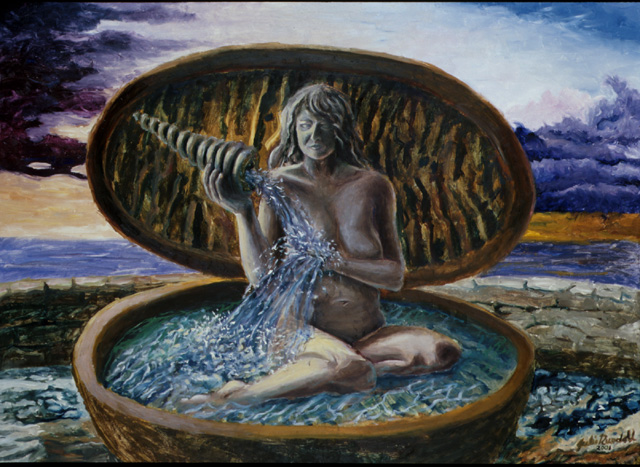
Superoxide Dismutase Fountain of Youth Number Two, 33" x 44", 2001. Available for purchase, $3,000.Prints available for $450.
In the scientific search for extension of the human life span, one technique involves mimicking the action of the enzyme superoxide dismutase. This enzyme traps harmful byproducts of metabolism and turns them into harmless oxygen and water. As humans age, this enzyme is not produced in as great a quantity, leaving tissues and genetic material vulnerable to the toxic products of metabolism. A drug was invented which mimics the action of superoxide dismutase (EUK-8 and EUK-134) and tested on the worm Caenorhabditis elegans. The life span of the worm was indeed increased by about 54%. Much of this sort of metabolism takes place in the mitochondria.
This is the second in a fountain of youth series. The fountain depicts a female statue sitting in a mitochondria, holding the horn of a Unicorn to symbolize superoxide dismutase. The Unicorn horn was thought to have the power to turn poisons into water. Here it is pouring out its product of air and water to create the fountain.
Inspired by the paper "Extension of Life-Span with Superoxide Dismutase/Catalase Mimetics", by Simon Melov, 1 Joanne Ravenscroft, 2 * Sarwatt Malik, 2, Matt S. Gill, 2 David W. Walker, 2 † Peter E. Clayton, 2, Douglas C. Wallace, 3 Bernard Malfroy, 4 Susan R. Doctrow, 4, Gordon J. Lithgow 2
1 Buck Institute for Age Research, Novato, CA 94949, USA. 2 The School of Biological Sciences and the Academic Unit of Child Health, The University of Manchester, Manchester, M13 9PT, UK. 3 Center for Molecular Medicine, Emory University, Atlanta, GA30322, USA. 4 Eukarion, Bedford, MA 01730, USA.
Programmed
Cell Death:
Apoptosis

